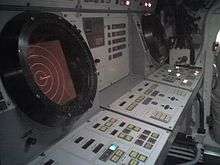Museo Nazionale Scienza e Tecnologia Leonardo da Vinci
 | |
| Established | 1953 |
|---|---|
| Location | Via S. Vittore 21 - 20123 Milan - Italy |
| Director | Fiorenzo Galli |
| Website | http://www.museoscienza.org/english/ |
The Museo nazionale della Scienza e della Tecnologia "Leonardo da Vinci" in Milan is the largest science and technology museum in Italy, and is dedicated to Italian painter and scientist Leonardo da Vinci. It was opened on 5 February 1953, inaugurated by prime minister of Italy, Alcide De Gasperi.[1]
This museum, in the ancient monastery of San Vittore al Corpo of Milan, is divided in seven main departments:[2]
- Materials
- Transport
- Energy
- Communication
- Leonardo da Vinci, Art & Science
- New Frontiers
- Science for young people
All this departments have also some laboratories especially for children and young students. The Transport section in made by four different parts: air, rail, water and Submarine Enrico Toti-S-506.[3]
Materials Section
The Materials section treats the life cycle of modern products from raw materials to recycling. Specific sections are dedicated to polymeric and synthesis materials and to the basic chemical manufacturing. There is also a metal section that illustrates the metal extraction and processing techniques and exhibits the first electric arc furnace for melting steel invented in 1898 by Ernesto Stassano.
Transports Section
The transport section is divided in four different sections:
- The Air transport section exhibits several airplanes including a Farman 1909 replica and an original Macchi MC 205 V used by the Regia Aeronautica Militare Italiana during the Second World War. There are also several modern military aircraft like an Italian Fiat G.91, a North American F-86K and a Republic F-84F Thunderstreak.
- The Rail Transport section is sited in a pavilion from the 1906 Expo with an added reconstruction of a late 19th-century railway station facade. The collection exhibits vehicles from 19th and 20th century with a particular attention for the historical public transport of Lombardy.
- The Water transport section is mainly characterized by the command bridge of the transatlantic liner Conte Biancamano and the entire brig Ebe launched in 1921. Also exposed are a slow running torpedo (or Maiale) and an explosive punt (1940) both used by the Italian Royal Navy in the Second World War.
- The last section is dedicated to Toti submarine S-506 built by Italian shipbuilders after the second world war for the Italian Navy and launched in 1967.
Energy Section
The Energy section is dedicated to energy sources and device. In this part of the museum there are the Margherita thermoelectric power station (1895) and an oil industry/petrochemistry section.
Communication Section
The communication section is divided in three different areas:
- The Astronomy section shows several antique astronomic and topographical instruments including two celestial and earth globe of 17th century, the Salmoiraghi refracting telescope and a Foucault pendulum.
- The Telecommunication section is dedicated to all form of modern era communication from telegraph to telephone and wireless communication, and from radio to the modern television with a global view of the technical history of Italian television.
- The Sound section shows main technologies for recording and reproducing sound from the 19th century to the modern times.
Leonardo da Vinci, Art & Science Section

One of the most characteristic sections of the museum is the Leonardo da Vinci, Art & Science area. This department of the museum is divided in four parts:
- The Jewelery collection shows precious objects from stones and gems to metals including gold and ivory jewelry.
- The Leonardo da Vinci section exhibits many Leonardo Machine reproduced from Da Vinci drawings like an hydraulic saw, a spinning machine, a flying machine or the Leonardo’s Tank. The models of the collection are the fruit of a reinterpretation, by a group of expert, which has translated and completed his drawings.
- The Horology collection shows the evolution of watchmaking and shows several pendulums, ancient clocks, personal watches and tower mechanisms.
- The Musical Instruments section exhibits instruments from 17th to 20th centuries. A reconstruction of a lutemaker’s workshop from the 17th century is exposed in this part of the museum.
Gallery

- View of some trains in the museum.
- Another view of rail section of the museum.
- An Italian Financial Guard helicopter.

 Control room for torpedoes of Submarine Enrico Toti-S-506.
Control room for torpedoes of Submarine Enrico Toti-S-506. An Italian Human Torpedo.
An Italian Human Torpedo. Regina Margherita Thermal Power Plant.
Regina Margherita Thermal Power Plant. The Cenacolo hall, frescoed by Pietro Gilardi
The Cenacolo hall, frescoed by Pietro Gilardi
See also
References
- ↑ http://www.museoscienza.org/english/
- ↑ http://www.museoscienza.org/english/departments/
- ↑ http://www.museoscienza.org/toti/
| Wikimedia Commons has media related to Museo della Scienza e della Tecnica (Milan). |
External links
Coordinates: 45°27′44.22″N 9°10′18.3″E / 45.4622833°N 9.171750°E.